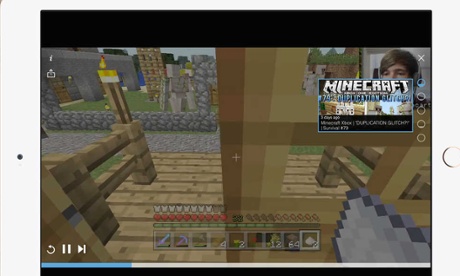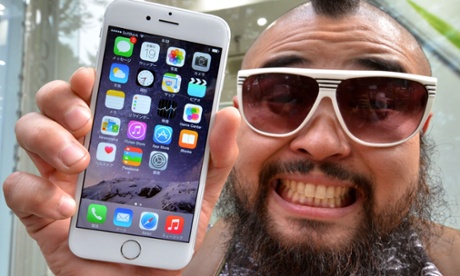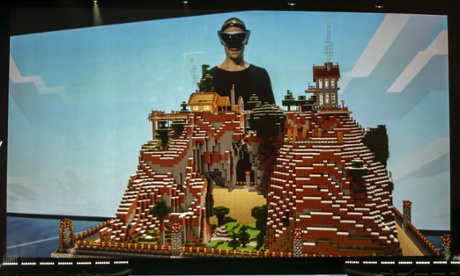Six of us are huddled together in Cavendish Square Gardens in central London, fighting a horde of warrior skeletons. To passersby, however, we must look like a bunch of adults pointing our smartphones at nothing while shouting about incoming monsters. This isn’t a bizarre new workplace therapy. What we’re doing is playing a beta version of Minecraft Earth, an augmented reality (AR) spinoff from the multimillion-selling block-building game – and very soon, parks all over the world will be filled with people just like us.
This month, Minecraft is launching an early-access version of the game in a select few territories around the world, ahead of a global roll-out. Microsoft has yet to reveal exactly when and where, but soon thousands of fans used to playing on their console, PC or tablet, are going to be taking their creations to the streets.
Built by a team at Microsoft’s Redmond campus, Minecraft Earth lets you construct models that can be viewed in real-world settings via your phone camera. You’ll be able to build a castle on your kitchen table, save it to memory, then view a lifesize version wherever you go – as long as there’s enough space for a virtual building made from 1m blocks, which can be up to 64 blocks high. The game also places collectible Minecraft blocks and objects – known as tappables – around your own neighbourhood, so while out walking, you can look at the map screen, see that there’s a treasure chest nearby, then tap on it to open it up and discover new resources to build with – perhaps a few planks of wood, some stone or a window.
Like the gigantically successful Pokémon Go, however, there are also specific story events, tied to various locations, that players can discover and interact with. When Microsoft showed the game to a group of journalists in Cavendish Square Gardens, one of these Adventure tasks was marked on the Minecraft Earth maps on our phones – the moment we tapped on it, a lifesize stone building sprang up among the trees, and immediately skeleton soldiers began pouring out for us to attack with our swords and bows and arrows. When you defeat the onslaught, you get to scoop up all the treasure they leave behind. Although both the building and the skeletons are visible only as graphical objects on our phone screens, it’s weird how quickly and completely you get sucked in, forgetting that the joggers doing laps of the square can’t see the epic struggle taking place.
The idea for Minecraft Earth came from an intriguing real-world project. In 2012, Mojang, the studio behind the Minecraft game, set up a charity named Block By Block, which allowed young people in developing countries to design new areas for their communities using the game. Working with the United Nations human settlements programme, these models and ideas could then be voted on and put into action, revitalising neglected or dangerous urban spaces.
“We thought, what if everyone could try this?” says game director Torfi Olafsson. “We found out there was research going on in the Microsoft cognition group, which works on the Hololens unit, which would allow us to place things with precision in physical space – that’s the technology Adventures use.”
Minecraft Earth employs Microsoft’s Azure cloud computing infrastructure to host and maintain the world, and Azure spatial anchors to place the persistent Adventure tasks in real-world locations. Each of these adventures is hosted on a single dedicated instance on the server, so everyone who sees an Adventure in a certain place can join in with other players and defeat enemies together. At the moment, the number of players able to join an instance is hard coded to a maximum of 40. “But it’s flexible,” says Olafsson. “It’s not a technical issue. It’s more about comfort and personal space.”
The game also employs the collaborative mapping software OpenStreetMap to place tappables in the world, using a proprietary algorithm that selects suitable areas based on safety and space concerns. “Our algorithms will never choose an area that doesn’t grant enough space for you to manoeuvre within and around the adventure, and we’ll also allow players to feedback if they don’t think an adventure is well-placed,” says Olafsson. “OpenStreetMap is a fantastic resource, an incredibly detailed map of the entire world complete with tagging. You can see if a particular space is a cemetery, a public park or even a military installation.”
Because the tags are generated by users, however, interesting errors can sometimes arise. “We had an issue with placing tappables in a particular neighbourhood of London,” says Olafsson. “We discovered that someone had tagged an upcoming extension of the underground as an overground train so our algorithm believed that there was a massive train line running through the area and excluded that neighbourhood completely.”
He also says that some of the OpenStreetMap tags highlight locations that are unsafe – or just unsavoury. “It’ll give you information about areas that are not so nice, like really shady clubs. We use these tags to generate a blacklist of where not to place items, but it’s often very interesting – especially if you were building a sort of augmented reality Grand Theft Auto game!”
Minecraft Earth has been in a prototyping phase for 18 months, and, over the last few weeks, a limited closed beta has taken place in key cities around the world – which has revealed some interesting issues. Players in Japan, for example, started to ride bullet trains so they could hoover up tappable objects much more quickly than just walking around their cities. “They were progressing too fast and it broke the system,” laughs Olafsson. “We had to install a speed limit on collecting in-game items.”
The game was pirated during the beta and quickly distributed on Android devices. “Overnight we were seeing people in South Africa, in small villages in Siberia, all across Asia, a huge player base in South America,” says Olafsson. “It was shocking to wake up in the morning, look at the data and see that the game had accidentally gone global. We can’t condone piracy, but it definitely validated our use of OpenStreetMap data to generate content. A random person in Papua New Guinea was able to take their phone out and collect tappables because the algorithm had made content.”
When the game enters open early access later this month, anyone in the supported territories (which Microsoft has not yet confirmed) will be able to download and play it while the team continues to iterate and improve the code. At the start, it’ll be possible to build and share only quite simple structures, although from the outset, you’ll be able to invite nearby players to collaborate on your projects. Later, Microsoft plans to define special areas in open public spaces where users will be able to showcase particularly impressive builds. Soon, perhaps, every park will have its own AR sculpture gallery.
Considering the huge success of the Minecraft brand, which just reached 176 million players, as well as the continuing popularity of Pokémon Go, and the fascinated looks we drew from other people in Cavendish Square Gardens, Minecraft Earth is going to be extremely popular. It will be interesting to see how stable the experience is with hundreds of thousands of people playing, and whether the development team is able to evolve the game overtime to keep people involved.
We have also yet to see exactly how Microsoft will monetise the game. It’s free to play, and to collect items, but there will be in-app purchases, perhaps providing quicker access to desirable rare blocks through payment options. Whatever the case, as a marker for the future of AR as a gaming platform, Minecraft Earth has fascinating ramifications.











